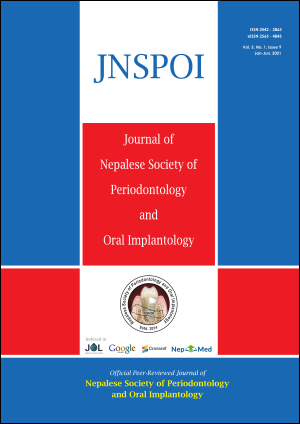Variations in Maxillary Frenal Morphology in a Sample of Newari Children of Bhaktapur
DOI:
https://doi.org/10.3126/jnspoi.v5i1.38181Keywords:
Location, Maxillary labial frenum, morphologyAbstract
Introduction: Frenum attachments are fold of mucous membrane attaching the lips to alveolar mucosa and underlying periosteum. Aberrant location of attachment of maxillary labial frenum poses many clinical problems such as mucogingival problems and midline diastema.
Objective: The study was performed to assess the variations in morphology of maxillary labial frenum in a sample of Newari children of Bhaktapur, Nepal.
Methods: A descriptive cross-sectional study was performed enrolling 340 Newari children residing in Bhaktapur from August 14, 2020 to March 30, 2021. The study comprised both genders within age group of 6 to 16 years. The frenal attachment was recorded according to Mirko and Sewerin classification. The data was analysed with Statistical Package for the Social Sciences version 16 using descriptive statistics.
Results: In total, 340 Newari children participated in this study. The mucosal type was observed in 204 (60%) of the participants followed by gingival type 101 (29.7%). More than 80% of the participants had simple frenum (283, 83.2%). The frenum with nodule was present in 25 (7.4%) and frenum with appendix in 22 (6.5%) of study participants. Frenum with appendix was mostly present in males 18 (10.1%) than females 4 (2.5%).
Conclusion: Within the Newari children, the mucosal type of maxillary labial frenum was more prevalent followed by gingival type. The simple frenum was the most common type on basis of morphology.
Downloads
Downloads
Published
How to Cite
Issue
Section
License
© Nepalese Society of Periodontology and Oral implantology (NSPOI)
Licenced by Creative Commons Attribution 4.0 International License.




